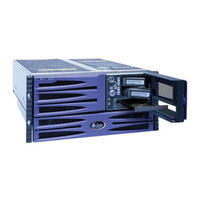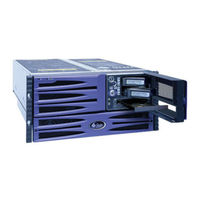
Sun Microsystems StorEdge 3000 Series Manuals
Manuals and User Guides for Sun Microsystems StorEdge 3000 Series. We have 6 Sun Microsystems StorEdge 3000 Series manuals available for free PDF download: Installation, Operation And Service Manual, Installation Manual, Best Practices Manual
Sun Microsystems StorEdge 3000 Series Installation, Operation And Service Manual (328 pages)
Brand: Sun Microsystems
|
Category: Network Hardware
|
Size: 10 MB
Table of Contents
-
Disk Drives30
-
FC Protocols33
-
Scalability35
-
Layout Map43
-
Checking Leds165
-
Front Panel Leds165
-
Back Panel Leds166
-
Battery Status172
-
Identifying Fans187
-
Patch Downloads193
-
Manual Rebuild204
-
Drive Leds215
-
Front Panel Leds217
-
LUN Mappings256
-
Cable Pinouts261
-
RJ-45 Connector261
-
DB9 COM Port262
Advertisement
Sun Microsystems StorEdge 3000 Series Installation, Operation And Service Manual (318 pages)
Brand: Sun Microsystems
|
Category: Network Hardware
|
Size: 8 MB
Table of Contents
-
Figures
15-
Preface21
-
-
-
Disk Drives30
-
FC Protocols32
-
Scalability34
-
-
Layout Map43
-
-
-
Checking Leds141
-
Front Panel Leds141
-
Back Panel Leds145
-
-
Main Menu152
-
Identifying Fans169
-
Patch Downloads175
-
Manual Rebuild185
-
Drive Leds199
-
Front Panel Leds202
-
Hardware Loop ID211
-
-
Sun Storedge CLI221
Sun Microsystems StorEdge 3000 Series Installation, Operation And Service Manual (242 pages)
Brand: Sun Microsystems
|
Category: Storage
|
Size: 4 MB
Table of Contents
-
Preface11
-
Task Map19
-
Layout Map25
-
Systems83
-
Rear-Panel Leds101
-
Main Menu110
-
Patch Downloads126
-
Manual Rebuild136
-
LUN Mappings168
-
Connector175
Advertisement
Sun Microsystems StorEdge 3000 Series Installation Manual (96 pages)
Brand: Sun Microsystems
|
Category: Computer Hardware
|
Size: 3 MB
Table of Contents
-
Battery Frus35
Sun Microsystems StorEdge 3000 Series Best Practices Manual (86 pages)
Brand: Sun Microsystems
|
Category: Disk array system
|
Size: 11 MB
Table of Contents
-
Preface
11 -
-
-
-
-
-
Limitations60
Sun Microsystems StorEdge 3000 Series Installation Manual (40 pages)
Rack Installation Guide for 2U Arrays
Brand: Sun Microsystems
|
Category: Server
|
Size: 1 MB
Table of Contents
Advertisement
Related Products
- Sun Microsystems Netra st D130
- Sun Microsystems Sun Java SystemDirectory Server
- Sun Microsystems Sun
- Sun Microsystems SPARC Enterprise T1000
- Sun Microsystems Sun Enterprise 4000
- Sun Microsystems Sun Enterprise 10000 DR 2.0
- Sun Microsystems Sun Netra T5440
- Sun Microsystems StorageTek SL48
- Sun Microsystems SAN
- Sun Microsystems Sun N2000 Series





